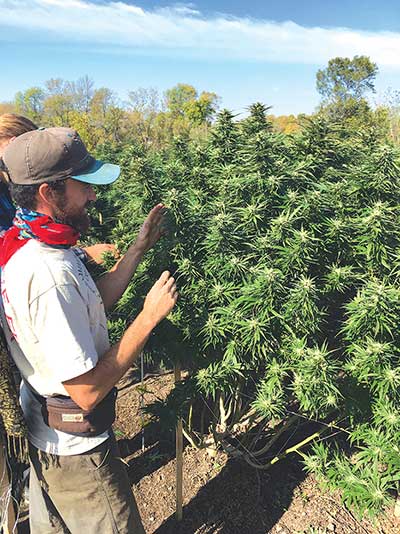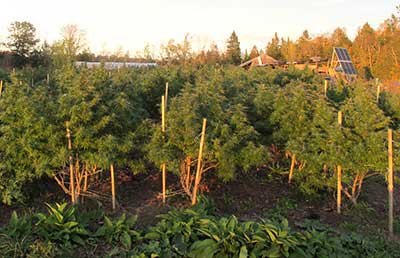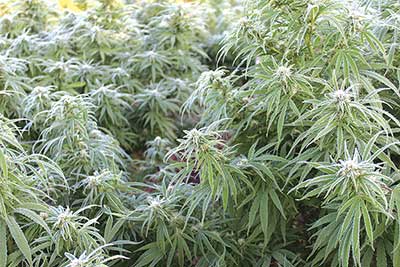 |
| Top buds are the most potent part of the plant. Plenty of trimming and pruning in September enables plants to put more energy into the top buds and increases the overall proportion of top buds in the harvest. |
 |
| Most of our garden beds have been no-till for five years and are surrounded by comfrey (bottom of photo). These plants were clones, so they needed a lot of support in September. We space plants 7-by-7 feet apart, which allows ample room for root growth, and shade for summer grown lettuce and greens. |
 |
| Frosty plants after a nighttime low of 24 F. Some stress helps many plants produce better, sweeter and more-nutrient-dense flowers and fruits. Hemp is no different. |
By Ben Rooney
This article is not a primer on CBD (cannabidiol) hemp cultivation, benefits or medicine-making but offers my impressions and experiences on a new landscape of cannabis production and marketing.
Wild Folk Farm, which I manage, is a small-scale, human-powered farm in Benton, Maine, focused on mixed fruit and veggies and rice production. In 2017, before CBD took off in the East, a handful of Maine growers – including Wild Folk – received hemp licenses.
Last winter I was on the verge of scrapping this new endeavor. I had originally thought the hemp sales experience would resemble that of our rice. It is a local, sustainable option, something new to the area, and a product that stores in Maine were not carrying. As I entered the Wild West of CBD marketing, however, I found that I was wrong.
From my experience, many wellness departments function differently from food departments, often due to lack of staffing, the added knowledge required to advise customers about health products, and different priorities. Yet customer demand helps guide purchasers at these stores. Many health products come from large corporate farms through aggregated distributors that sell in bulk and package complementary products together for convenient wholesale purchasing. I learned that many retail locations were getting more calls and emails for new CBD products than for all other new products combined. Purchasing agents were inundated with producers clamoring to get their new, high-demand hemp products on shelves, and stores were being bombarded with new health and CBD product information.
Deeper reasons for the difference between hemp and rice/veggies experiences were largely tied to money. Small-scale farmers with good practices aren’t in the game for big money, while some others in the cannabis world seem more competitive and growth-oriented. After eight years of exclusively solid and trustworthy business interactions related to food production, I quickly found the world of hemp CBD colored with distrust and deception after a series of trying engagements with potential collaborators, distributors and farmers. (I have also met some amazing and inspirational people in the cannabis field.)
For example, the owner of the farm next to ours leased his land to a grower who was eager to get a share of the CBD pie. The grower assured me that none of his plants would be males because they were vegetatively propagated female clones. Female flowers of CBD hemp have the highest concentrations of the terpenes and endocannabinoids that we are seeking. Pollen can devastate a crop, especially one as small as ours, as pollinated plants put their energy into seed formation, and cannabinoid content plummets.
Unfortunately, our neighbor’s planting did include hundreds of male plants, which we spent hours removing. Other neighbors were not informed before his planting; many didn’t know the difference between marijuana and hemp, or about cultivation laws; the police were called to inspect his land; and many thought his project was connected to Wild Folk Farm, which actually is secluded enough that neighbors can neither see nor smell our crop.
Also, as 2018 unfolded, retailers told me of scare tactics wielded by large hemp businesses to turn them against small operations – e.g., warning that our crop may not be clean or meet quality standards, and that having any THC in the crop is illegal and is not good for business.
Furthermore, while the 2018 farm bill legalizes hemp, the FDA still has CBD on the same standing as THC (tetrahydrocannabinol, the principal psychoactive compound in some cannabis strains). While CBD isolate extractions are possible, Wild Folk Farm believes in the power of full plant extracts, not in isolates nor reformulations that can’t offer synergistic health benefits. Maine law states that hemp is a cannabis variety with less than 0.3 percent THC. Tests of the best parts of Wild Folk plants show 15 percent CBD and less than the prohibited levels of THC.
The increasing popularity of high-technology-dependent extractions and the proliferation of products (edibles, ointments, vape cartridges, capsules) seems to be pulling us further from the origins of this plant as medicine for the sake of capitalism, consumerism and technocracy. What happened to just putting plant material in alcohol and letting it sit for a few weeks – a process that uses far less energy than high-tech extraction methods?
People contact me weekly about getting into the hemp business, but in the past year, as production in Maine has gone from 15 to 1,000 acres, prices have dropped tenfold unless you market directly to consumers. Plants produce 1 to 2 pounds of material, and at $20 to $75 per pound, the market price is starting to resemble that of some vegetables. Our half-acre operation makes me wonder, “Where does all this other hemp go?” A significant amount likely stays in the cannabis world of dispensaries and caretakers, and some surely goes to national distributors. Most of our product goes to stores with no other relationship to cannabis other than CBD. With hemp being federally legal and the CBD market starting to become inundated, I expect more industrial hemp to be grown and processed for fiber.
Unfortunately, many people have had tainted experiences with CBD due to pesticide residues and lack of quality in some (often foreign) products, and due to marketing bombardments and the stigma of cannabis culture. For many, however, this crop is changing their lives much faster than any carrot or bowl of rice. The long list of alleged benefits can seem unbelievable, and dosage, sensitivities and effectiveness can range widely, but CBD seems to be able to help with dozens of ailments. I hear anecdotes regularly. At one farmers’ markets, I sold some salve and tincture to a woman in a wheelchair for her neuropathy. Two weeks later she was doing jumping jacks in front of me. For many people, CBD has replaced a panoply of pharmaceuticals – especially for alleviating pain and addressing issues tied to the nervous system. As breeding continues, products high in other beneficial cannabinoids (e.g., CBC or cannabichromene, CBN or cannabinol, CBG or cannabigerol) will likely be developed to treat even more ailments.
Customers become loyal to an effective medicinal product, so our products are expanding into more stores. That gives me hope that big business may not swallow this industry, but at the same time explains why so many pharmaceutical companies are getting into the hemp world: They know of its potential.
Growing CBD Hemp
Grow hemp as you would a marijuana or tomato plant. Don’t feed it too much, and don’t add fertilizers high in nitrogen after July. Seedlings can do well in a variety of soils. Harvest will likely take place between September 15 and October 15 in Maine. CBD concentrations often peak about a week later in the flowering period than THC concentrations.
Average night temperatures usually are too low for growth by mid-October. Many CBD varieties are much less likely than THC varieties to get bud rot.
We harvest whole plants and dry them upside-down in our hoophouse.
CBD breaks down slower than THC, but the product is still best stored in an airtight container.
We initially grew clones, which have more consistent CBD:THC ratios than seedlings. That helps create a reliable recipe for tinctures or salves. We are switching to seed-propagated stock, however, because seeds have more vigor, can grow better in our heavy clay soil and require less trellising. One downside is that we will have to rogue male plants, but with our small scale, that shouldn’t be a problem. Also, breeding populations have been developed with more stable phenotypes. This is important because the state government takes samples near harvest time, and if that small sample tests above 0.3 percent THC, the state can take the harvest.
Mainers can legally grow up to three hemp or marijuana plants without a license. Three plants can provide all your CBD needs and can easily be make into tinctures and salves. Those growing more than three hemp plants should check the state’s industrial hemp licensing program at https://www.maine.gov/dacf/php/hemp/.
Cultivation methods depend on the purpose of the crop and the scale of growth. ProjectCBD.org and leafly.com offer guidance.
I am not aware of any local, commercial seed outlets yet. We have gotten quality, reliable seeds and clones from Colorado.
Disclaimer: This article is for informational purposes only. Please consult your health care provider regarding diagnoses and/or medical treatments.
